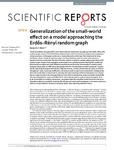Generalization of the small-world effect on a model approaching the Erdős–Rényi random graph
Maier, Benjamin F.
The famous Watts–Strogatz (WS) small-world network model does not approach the Erdős–Rényi (ER) random graph model in the limit of total randomization which can lead to confusion and complicates certain analyses. In this paper we discuss a simple alternative which was first introduced by Song and Wang, where instead of rewiring, edges are drawn between pairs of nodes with a distance-based connection probability. We show that this model is simpler to analyze, approaches the true ER random graph model in the completely randomized limit, and demonstrate that the WS model and the alternative model may yield different quantitative results using the example of a random walk temporal observable. An efficient sampling algorithm for the alternative model is proposed. Analytic results regarding the degree distribution, degree variance, number of two-stars per node, number of triangles per node, clustering coefficient, and random walk mixing time are presented. Subsequently, the small-world effect is illustrated by showing that the clustering coefficient decreases much slower than an upper bound on the message delivery time with increasing long-range connection probability which generalizes the small-world effect from informed searches to random search strategies. Due to its accessibility for analytic evaluations, we propose that this modified model should be used as an alternative reference model for studying the influence of small-world topologies on dynamic systems as well as a simple model to introduce numerous topics when teaching network science.
Files in this item

